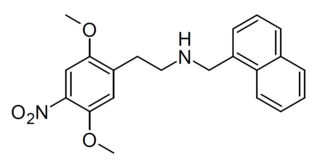
A serotonin receptor agonist is an agonist of one or more serotonin receptors. They activate serotonin receptors in a manner similar to that of serotonin, a neurotransmitter and hormone and the endogenous ligand of the serotonin receptors.

25I-NBOMe, also known as Smiles, or N-Bomb, is a novel synthetic psychoactive substance with strong hallucinogenic properties, synthesized in 2003 for research purposes. Since 2010, it has circulated in the recreational drug scene, often misrepresented as LSD.

25B-NBOMe is a derivative of the phenethylamine psychedelic 2C-B, discovered in 2004 by Ralf Heim at the Free University of Berlin. It acts as a potent full agonist for the 5HT2A receptor. Duration of effects lasts about 3–10 hours, although the parent compound is rapidly cleared from the blood when used in the radiolabeled form in tracer doses. Recently, Custodio et al. (2019) evaluated the potential involvement of dysregulated dopaminergic system, neuroadaptation, and brain wave changes which may contribute to the rewarding and reinforcing properties of 25B-NBOMe in rodents.

RH-34 is a compound which acts as a potent and selective partial agonist for the 5-HT2A serotonin receptor subtype. It was derived by structural modification of the selective 5-HT2A antagonist ketanserin, with the 4-(p-fluorobenzoyl)piperidine moiety replaced by the N-(2-methoxybenzyl) pharmacophore found in such potent 5-HT2A agonists as NBOMe-2C-B and NBOMe-2C-I. This alteration was found to retain 5-HT2A affinity and selectivity, but reversed activity from an antagonist to a moderate efficacy partial agonist.

25I-NBF is a derivative of the phenethylamine hallucinogen 2C-I, which acts as a highly potent partial agonist for the human 5-HT2A receptor, with bias towards the β-arrestin 2 coupled signalling pathway. It has been studied in its 11C radiolabelled form as a potential ligand for mapping the distribution of 5-HT2A receptors in the brain, using positron emission tomography (PET).

25TFM-NBOMe is a derivative of the phenethylamine hallucinogen 2C-TFM, discovered in 2004 by Ralf Heim at the Free University of Berlin. It acts as a potent partial agonist for the 5-HT2A receptor, though its relative potency is disputed, with some studies finding it to be of lower potency than 25I-NBOMe, while others show it to be of similar or higher potency, possibly because of differences in the assay used. 2C-TFM-NB2OMe can be taken to produce psychedelic effects similar to 2C-I-NB2OMe and 2C-D-NB2OMe.

25C-NBOMe is a psychedelic drug and derivative of the psychedelic phenethylamine 2C-C. 25C-NBOMe appeared on online vendor sites in 2010 but was not reported in the literature until 2011. It acts as a potent agonist of the 5-HT2A receptor, and has been studied in its 11C radiolabelled form as a potential ligand for mapping the distribution of 5-HT2A receptors in the brain, using positron emission tomography (PET). Multiple deaths have occurred from usage of 25C-NBOMe due to the ease of accidental overdose. The long-term toxic effects of the drug have not been researched.

25D-NBOMe is a derivative of the phenethylamine derived hallucinogen 2C-D. It acts in a similar manner to related compounds such as 25I-NBOMe, which is a potent agonist at the 5-HT2A receptor. 25D-NBOMe has been sold as a street drug since 2010 and produces similar effects in humans to related compounds such as 25I-NBOMe and 25C-NBOMe. It was banned as a Temporary Class Drug in the UK on 10 June 2013 after concerns about its recreational use.

25N-NBOMe is a derivative of the hallucinogen 2C-N. The pharmacological properties of 25N-NBOMe have not been described in the scientific literature, but it is believed to act in a similar manner to related compounds such as 25I-NBOMe and 25C-NBOMe, which are potent agonists at the 5HT2A receptor. 25N-NBOMe has been sold as a street drug and has only been described in the literature in terms of identification by forensic analysis.

25E-NBOMe is a derivative of the phenethylamine 2C-E. It acts in a similar manner to related compounds such as 25I-NBOMe, which are potent agonists at the 5-HT2A receptor. 25E-NBOMe has been sold as a drug and produces similar effects in humans to related compounds such as 25I-NBOMe and 25C-NBOMe.

25P-NBOMe is a derivative of the phenethylamine 2C-P. It acts in a similar manner to related compounds such as 25I-NBOMe, which are potent agonists at the 5-HT2A receptor. 25P-NBOMe has been sold as a drug and produces similar effects in humans to related compounds such as 25I-NBOMe and 25C-NBOMe.

NBOMe-mescaline or mescaline-NBOMe is a synthetic substituted phenethylamine. It is a partial agonist of serotonin receptors with a 5-HT2A pKi originally reported as 7.3, though more modern techniques assayed it as 140nM at 5-HT2A and 640nM at 5-HT2C, making it one of the least potent compounds among the N-benzyl phenethylamines.

25G-NBOMe (NBOMe-2C-G) is a derivative of the phenethylamine hallucinogen 2C-G, which acts as a highly potent agonist for the human 5-HT2A receptor.

25H-NBOMe (NBOMe-2C-H) is a derivative of the phenethylamine hallucinogen 2C-H, which acts as a highly potent full agonist for the human 5-HT2A receptor.

25iP-NBOMe is a derivative of the phenethylamine hallucinogen 2C-iP, which acts as a highly potent agonist for the human 5-HT2A receptor.

The 25-NB (25x-NBx) series, or NBOMe series, also known as the N-benzylphenethylamines, is a family of serotonergic psychedelics. They are substituted phenethylamines and were derived from the 2C family. The most commonly encountered NBOMe drugs are 25I-NBOMe, 25B-NBOMe, and 25C-NBOMe.

25T7-NBOMe is a substituted phenethylamine derivative from the 25-NB family. It acts as an agonist at the 5-HT2A and 5-HT2C serotonin receptors, has psychedelic effects and has been sold as a designer drug.

2C2-NBOMe (NBOMe-MMDPEA-2) is a phenethylamine derivative from the 25-NB class. It acts as a potent agonist at the 5-HT2A receptor with weaker activity at 5-HT2B and 5-HT2C, and produces a head-twitch response in animal studies which often correlates with potential for psychedelic effects in humans. It is related in structure to psychedelic amphetamine derivatives such as MMDA-2 and is the first phenethylamine derivative with a methylenedioxy substitution on the phenyl ring but no alkyl substitution on the alpha carbon, that has been shown to produce psychedelic-appropriate responding in animals.

25N-NBPh (NBPh-2C-N) is a phenethylamine derivative from the 25-NB class, which acts as a potent agonist at the 5-HT2A receptor with weaker activity at 5-HT2B and 5-HT2C. 25N-NBPh is a biased agonist, producing robust activation of 5-HT2A coupled signalling pathways mediated by beta arrestin 2, but with only slight activation of pathways mediated via Gq. In animal studies it produces a modest head-twitch response when administered by itself, but blocks the effects of the fully active psychedelic DOI.

25N-N1-Nap is a phenethylamine derivative from the 25-NB class, which acts as a potent agonist at the 5-HT2A receptor with weaker activity at 5-HT2B and 5-HT2C. 25N-N1-Nap is a biased agonist, producing robust activation of 5-HT2A coupled signalling pathways mediated by beta arrestin 2, but with little or no activation of pathways mediated via Gq. In animal studies it produces antipsychotic effects but without producing the head-twitch response associated with psychedelic activity.




















